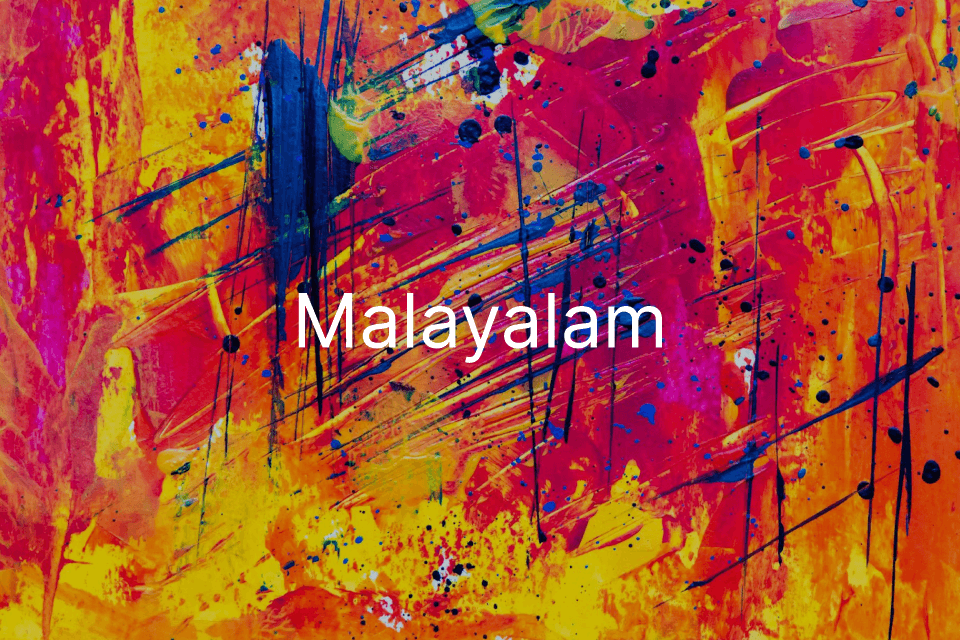Malayalam: A Guide to the Language of Kerala

TABLE OF CONTENTS
Malayalam, the official language of Kerala, India, is spoken by about 38 million people worldwide. As a classical Dravidian language with a unique script and rich literary tradition, learning Malayalam opens doors to Kerala’s vibrant culture and history.
Introduction to Malayalam: A Cultural Gateway
Malayalam is the official language of Kerala and Lakshadweep, with a global diaspora in the UAE, Malaysia, and the USA. Recognized as a classical language in 2013, it’s one of India’s 22 scheduled languages, ranking ninth by speaker count with about 38 million native users. Its name, from “Mala” (mountain) and “Alam” (land), reflects Kerala’s scenic geography.
The language uses the Malayalam script (which evolved from the historical Kolezhuthu), known for its rounded, flowing letters, and features agglutinative grammar with a subject-object-verb (SOV) order. Malayalam’s cultural significance shines in its literature, films, and music, making it an exciting choice for learners eager to connect with Kerala’s vibrant traditions.
A Brief History of Malayalam
Malayalam evolved from Tamil around the 9th century, becoming distinct by the 13th century. Shaped by Kerala’s Western Ghats, it developed unique traits, absorbing Sanskrit vocabulary for religious and philosophical terms, like “Namaskaram” (hello) from Sanskrit “Namaskar.”
The earliest literary work, Ramacaritam (c. 830 CE), marks the start of Malayalam’s literary tradition. In the 16th century, Thunchaththu Ezhuthachan, dubbed the “Father of Modern Malayalam,” formalized its script and grammar. Today, Malayalam boasts award-winning writers, including Jnanpith Award recipients, and a thriving film industry, known as Mollywood.

Why Learn Malayalam?
Learning Malayalam offers practical and cultural benefits:
- Travel and Communication: Navigate Kerala’s markets, festivals, and backwaters confidently.
- Cultural Immersion: Engage with Malayalam literature, music, and films on platforms like Netflix and Disney+ Hotstar.
- Heritage Connection: Reconnect with roots for diaspora communities.
- Cognitive Benefits: Master a new script and grammar to boost memory and problem-solving skills.
With digital tools and growing online content, learning Malayalam is more accessible than ever.
Getting Started: Key Features of Malayalam
The Malayalam Script
Malayalam’s Malayalam script has 52 letters (15 vowels, 37 consonants), written left to right. Its phonetic nature—each letter represents a distinct sound—simplifies pronunciation once learned. The script’s curved, aesthetic forms are popular in calligraphy and digital fonts.
.jpg)
- Tip: Familiarize yourself with the unique aesthetic of Malayalam; many learners find its rounded characters beautiful and engaging. [Consider adding an image of the Malayalam alphabet here]
Grammar Essentials
Malayalam is agglutinative, forming words with suffixes (e.g., “veedu” [house] becomes “veedu-il” [in the house]). It uses an SOV (Subject-Object-Verb) order, unlike English’s SVO, and employs postpositions instead of prepositions. A nuanced honorific system adjusts speech for peers, elders, or subordinates, which is key for polite communication.
Essential Phrases
Start with these for daily interactions:
- Hello (formal): Namaskaram
- Hello (informal): Aay or “a’ye”
- How are you?: Sukhamaano?
- Thank you: Nanni
- What is your name?: Ningalude peru enthaanu?
- Numbers 1-5: Onnu (1), Randu (2), Moonnu (3), Naalu (4), Anchu (5)
How to Learn Malayalam: Practical Tips and Resources
Step-by-Step Learning Plan
- Master the Script: Use flashcards or apps to learn the 52 letters of the Malayalam script, practicing their shapes.
- Build Vocabulary: Memorize common phrases and numbers, focusing on pronunciation with audio tools.
- Understand Grammar: Learn the SOV structure and basic suffixes through beginner guides.
- Immerse Yourself: Watch Malayalam films, listen to songs, or follow Kerala-based YouTube channels.
- Practice Speaking: Use language exchange platforms to converse with native speakers.
Top Resources
These curated tools will accelerate your learning:
- Online Courses: The University of Texas at Austin offers a free textbook, Malayalam: A University Course and Reference Grammar, with audio files (UT Austin Malayalam Course).
- Apps: Ling (Ling App) provides interactive lessons; Memrise (Memrise) focuses on vocabulary.
- Websites: Akshharam (Akshharam) offers structured courses; Hilokal (Hilokal) provides interactive lessons.
- Translation Tool: OpenL’s image translation tool (OpenL Translate) instantly translates Malayalam text from images, perfect for reading signs, menus, or books on the go.
- YouTube: EliKutty (EliKutty) delivers free lessons and community engagement via Discord.
- Language Exchange: italki (italki) connects you with native tutors for conversational practice.
Immersion Tips
- Media: Stream Malayalam films on OTT platforms or listen to folk songs to learn natural expressions and intonation.
- Community: Join online forums or local Kerala cultural events for informal practice.
- Daily Practice: Spend 15–30 minutes daily on apps, flashcards, or translation tools like OpenL to build consistency.
Challenges and How to Overcome Them
- Script Complexity: The 52-letter Malayalam script can be intimidating. Learn 5–10 letters daily using mnemonic devices or apps.
- Grammar Differences: The SOV order and agglutinative structure differ from English. Practice simple sentences like “Njan chorum” (I eat rice) to adapt.
- Pronunciation: Malayalam has unique sounds that can be challenging, such as its retroflex consonants (e.g., the ‘l’ in ‘Malayalam’ often has a subtle retroflex quality). Use audio from Ling or OpenL’s tool to mimic native tones and focus on articulation.
- Motivation: Set small, achievable goals, like learning 10 phrases weekly, and celebrate your progress to stay engaged.
The Future of Malayalam Learning
Malayalam’s digital presence is expanding with tools like OpenL’s image translation, machine translation, and speech recognition. Institutions like Thunchath Ezhuthachan Malayalam University offer digital courses, while OTT platforms boost access to Malayalam content. As AI-driven learning aids grow, Malayalam will become even more accessible globally.
Conclusion
Learning Malayalam is a journey into Kerala’s heart, blending linguistic challenge with cultural discovery. From its ancient roots to modern tools like OpenL’s translation feature, Malayalam offers a unique learning experience. Start with the Malayalam script, practice key phrases, and leverage resources like UT Austin’s course, Ling, or OpenL. Whether for travel, heritage, or curiosity, your efforts will unlock a world of literature, cinema, and connection. Say “Namaskaram” to your Malayalam adventure today!


